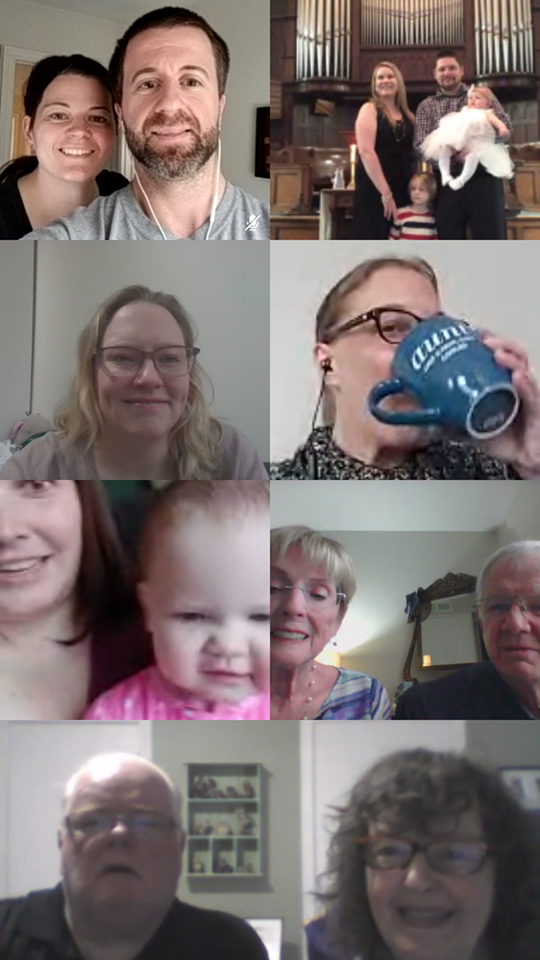While there’s no true substitute for face-to-face interaction, there are now more ways than ever to connect virtually while we are apart. Like many people, I’ve started using video chat and conferencing services to connect with friends, family, and colleagues during this time of quarantine, from meetings with my team on Google Meet and hangouts with friends on HouseParty, to family catch ups on Whatsapp. I even watched my niece’s baptism over Facebook Messenger the other day.

As I’ve been writing this blog, there’ve been daily announcements from developers about upgrades, new features, and new products to meet the demands of the socially distanced world we now find ourselves in. If you haven’t already landed on your video chatting app of choice, here are a few to consider, all of which are free to use and work across platforms and devices:
At first I was going to mention Hangouts, Google’s original voice, video, and instant messaging app. But then, Google announced it’s rolling out free access for individuals to Google Meet, its premium video conferencing product. By mid-May, Gmail users will be able to use Meet through their email account or with the Apple iOS or Android app. It’s not yet clear if this rollout will fully replace Hangouts for Gmail users. Google has already phased out Hangouts for G-Suite customers, and it’s what I’ve been using to connect with coworkers while I’ve been working from home. Meet looks and feels similar to Hangouts, but with some significant upgrades. There’s better video and audio quality, screen sharing, live captioning, and enhanced privacy and security. With Meet, you’ll be able to virtually gather up to 100 people for up to an hour, though Google says it won’t enforce the time limit until after September 30th. In the meantime, Hangouts is still a good option for Gmail users.
Duo is Google’s app specifically for video calls. Its interface is simple and intuitive and the video and audio quality are noticeably better than many of the other apps out there. You can link it to your phone number or your Google account. It comes preinstalled on most Android phones, but it can also be installed on Apple and Chrome OS platforms, making it easy to get people together on different devices. Duo, as the name implies, was originally designed for one-on-one video calls, however, the mobile app now supports chats for up to 12, and Google says it will be increasing this even further. Duo also has end-to-end encryption, which keeps your calls private.
The world’s most popular app for voice calls and texting is also a great video chat platform for mobile devices. WhatsApp just announced that its latest update increased video call capacity from 4 to 8. Like Duo, WhatsApp calls are secured with end-to-end encryption so no one else can view or listen in to your conversation.The app also scores points for its low data use, which is ideal if you don’t have access to a reliable Wifi connection. If you’re already on WhatsApp, and so are all your family and friends, this just might be your go-to.
The Messenger app is embedded in Facebook profiles, but there are also standalone mobile and desktop apps. Messenger supports video chat for groups of 8, however, Facebook has announced the rollout of Messenger Rooms, which will let you host gatherings of up to 50, for Facebook and non-Facebook users alike. There’s also Facebook Messenger for Kids, which lets kids safely video chat with parent-approved contacts. During this period of lockdown, a lot of my friends have been using it to let their youngsters have video playdates and calls with extended family. If you find yourself logged into Facebook often, along with all your frequent contacts, Facebook Messenger might be the most convenient choice.
Of all the video chat apps on the block, Houseparty is the most fun. The app invites you to throw a virtual get-together for up to 8 people, complete with built-in games such as Heads Up! and my personal favourite, Chips and Guac, a word association game reminiscent of Apples to Apples or Cards Against Humanity. If you’re on a PC or Apple device, you can also share your screen. Houseparty encourages impromptu gathering — just open the app and it alerts your friends that you’re “in the house.” Friends of friends can join in any room without permission, but if you prefer to keep your party exclusive, you can always lock the room.
There was a time when Skype and video calling were practically synonymous, and despite its age, it’s still a solid option. The video and audio quality is decent, and it has lots of built-in features that most of the other free apps don’t. There’s a whiteboard and screen sharing function, you can record and save your video chats, and there’s even subtitling and live translation for 10 languages. You can log on from practically any device — a smartphone, tablet, laptop, desktop computer, XBox console, web browser, or even a Smart TV. Admittedly, the interface is a bit clunky compared to its competitors, and the process of signing up for a Microsoft account can be a pain, but with free video chatting supported for up to 50 people, it’s one of the best available options for larger groups.
Zoom is perhaps the most notorious app on this list ( “Have You Been Zoom Bombed?”). In spite of this, there are a few reasons to consider it. It has the best video and audio quality of all the apps I’ve tried, and it supports the largest number of video participants — up to 100 at a time. There are ways to make your Zoom calls more secure, but they can be tricky to set up. If you’re not discouraged by the reported privacy and security vulnerabilities, you might be by the 40-minute time limit for free accounts. Zoom’s not normally my first choice for catching up with family and friends, but it has become so ubiquitous that chances are you'll encounter it when accessing an online class or presentation.
All of these apps will let you connect easily with friends and loved ones. When it comes down to deciding which one is right for you, consider the following:
- What are you already using? The best option might just be the app you and most of your family and friends are already on. You won’t need to create a new account and all of your contacts are already there.
- How many people do you want to video chat with? There’s a limit to the number of people each app can support, but all of them can handle at least 4 and usually more.
- Do you just want to video chat? Or would you prefer an app that lets you text chat simultaneously, share your screen, play a game, or have fun with filters?
- Are you concerned about privacy? The reality is that all apps collect and share data about users, but the level of privacy and security protections they have in place varies. The good news is that for everyday conversation and catch ups, all of the above apps are reasonably safe to use. Researchers at the Mozilla Foundation recently evaluated 15 popular apps, and — with the exception of Houseparty, thanks to its poor password requirements— all of the above apps met the Minimum Security Standards.
Regardless of the app you use, remember to practice good digital hygiene: use strong passwords and don’t reuse passwords for other accounts, keep your apps updated so that security patches are applied promptly, and don’t do or say anything over video chat that you might regret later. Even when an app is encrypted, that doesn’t prevent your conversation from being screen recorded without your knowledge. For this reason, you shouldn’t accept video chat requests from people you don’t know and trust.
If you need help getting up and running with some of these apps, check out these courses available from our Lynda.com service
- Use Meet for online video chats
- Google Hangouts Essential Training
- Learning WhatsApp
- Chatting Securely
— or feel free to connect with me at This email address is being protected from spambots. You need JavaScript enabled to view it.





 905-793-4636
905-793-4636